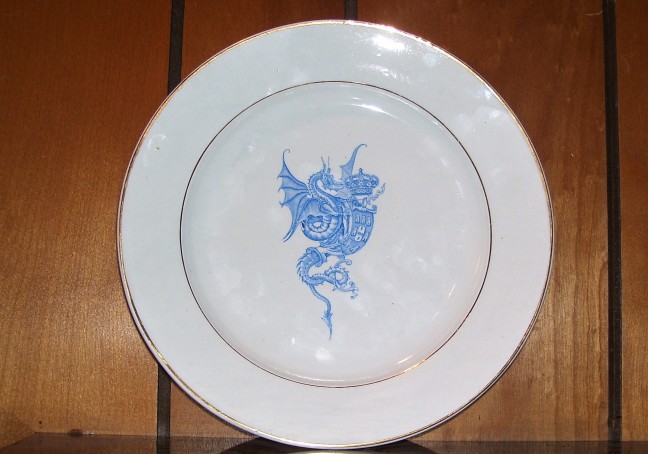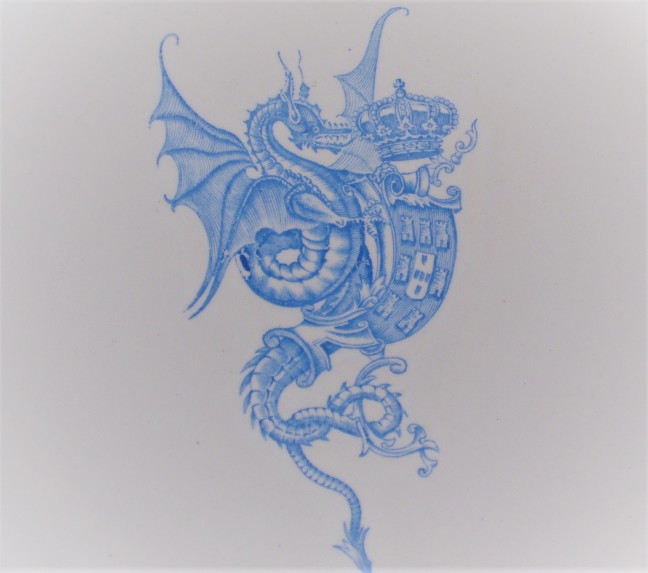Braganza! Two gold rings around a blue dragon—it’s a royal dish from Portugal.
This dish was purchased at the art museum during a designer showcase. The shallow bowl is white faience ceramic with two gold rings and a blue coat of arms of Portugal. It has the marking L & C Lisboa. (1)

The condition is nice, but there are several mistakes from manufacturing. There are one or two spots of underglaze grit. The transfer-printing of the dragon’s body has a mark on the body under the wing, which makes it appear to have a hole or a wound. Transfer-printing on pottery was developed in 1750s. The dish looks good, but is not perfect.
The design features the “Armas Reais,” the coat of arms of the King of Portugal, in a fanciful way. The shield with the coat of arms seems to be shackled to the coils of a dragon. The flying wyvern supports the shield, a crown and the letter C.

A wyvern is the kind of European dragon with two limbs, wings and a long body ending in a barbed tail. Usually there are two green wyverns, one on each side of the coat of arms of the House of Braganza, which is a symbol of the king of Portugal. Green was their livery color, and became the national color of the country. The crest of wyverns was removed in 1910 when Portugal was no longer a monarchy. (2)
Portugal’s coat of arms started with a blue cross on a white shield. With battle damage the blue stripes became five escutcheons. They recall the five wounds of Jesus Christ on the cross, or the five wounds of Afonso Henriques. The spots may represent plates, coins, or merely the nails on the original shield. After all these years, it’s hard to say. This coat of arms is called the Quinas, since a quina is group of five things. (3)
Around the cross is a red border with seven castles. These were added in the 1200s, and possibly are reference to the fall of Muslim strongholds to Christian forces. Or maybe the heritage of the king at the time.
The crown above the coat of arms has also changed over the years, depending on the monarchy. The circlet with leaves gained one arch, two, then four arches. On top is a globe with a cross. The crown was also removed in 1910, when Portugal became a constitutional republic.
The wyvern’s tail coils around the letter C. I can’t be sure, but my guess is C is for Carlos. Dom Carlos I was king from 1889 to 1908, when he was assassinated. He was of the House of Braganza-Saxe-Coburg and Gotha.
I only found one similar plate for sale online. It is listed at $104.06, plus shipping. The date is listed as late 19th or early 20th century, which matches to the reign of Carlos. It also says, “Similar examples are part of the collection of the Palácio da Pena – Pena Palace, Sintra, Portugal.” (4)
In this blank expanse, a blue wyvern, flying with crown and shield, has a wound, which I think is appropriate to King Carlos I, whose bankrupt reign ended with five shots by a sharpshooter.
Notes:
1. The backside marking says, “L & C LISBOA, FAIANÇA FINA, FABRICA D’ALCANTARA,” which translates as L & C Lisbon, Fine Faience, of Alcantara Factory. Alcântara is a parish of Lisbon.
